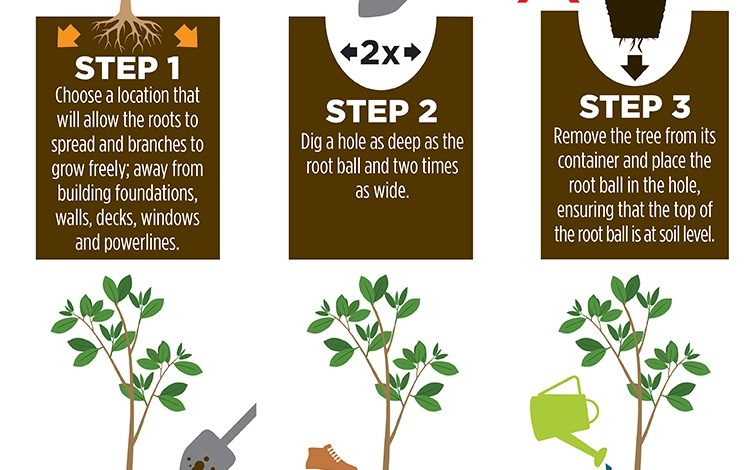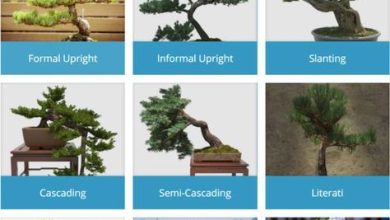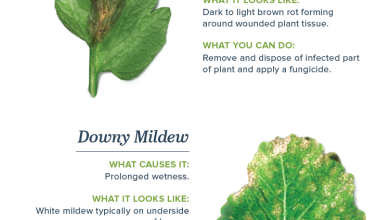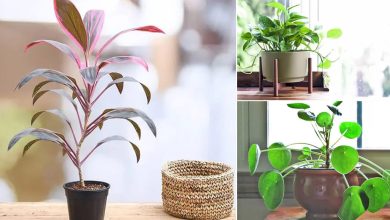How to Plant Trees: The Guide You Need to Get It in 12 Steps

Plant Trees Step by Step
- Dig the hole with a diameter and a depth that are double or triple the diameter of the roots of the tree that we want to transplant.
- We will dig deeper in arid and dry terrain. On the other hand, the hole will be more shallow in wetlands.

- In arid and loose soils, deposit highly decomposed compost to increase humidity. On wet land, put gravel to facilitate water drainage.
- We mix mulch with the subsoil layer of soil and deposit compost or gravel.
- We place the tree by means of a transplant, supporting its roots on the ground at the bottom and taking into account its verticality.
- It is very important at this time that the tree remains vertical, we can help with guides or stakes (sticks or reeds).
- We return to fill the hole with the earth that we had previously removed. We must have mixed this soil with 1/3 of the homemade organic matter as the total compost and that it is well decomposed.
- We press the earth and water afterwards (without flooding).
- In dry climates or hot summers, we can make a ridge or depression around the tree to facilitate water storage.
- It is highly recommended to finish by mulching with straw, grass clippings or leaves from other trees. This padding will have to be renewed from time to time.
Trick 1: If the area where you want to plant the tree is very windy, it is important that you guide or stake the tree with a sturdy stick or guide. Trick 2: When passing the motorized cultivator or motorized tiller (tillage), watch how and how often you do it because you damage the superficial roots through which diseases penetrate fruit trees more easily.
We recommend a good mulch made up of straw, grass clippings, leaves from other trees and even stones. In addition to drip irrigation in case it is a climate with little rain.
What Trees to Plant Ultra-Rapid Growth?
- Mulberry trees.

- Paulownia.
- ash trees
- Eucalyptus.
- Maples.
- Mimosas.
- Acacias.
- White Birch.
- Willows.
- Quince.
- Tipuana.
- The holly.
- The Walnut.
- The Granada.
- Paradise Tree.
- Washingtonia Robusta.
Maybe you are also interested in:
LTrees, in addition to giving us life, also provide us with great satisfaction.
Indeed, there is nothing more pleasant and relaxing than sitting in the shade of a tree to rest after a long day of work.
Trees bring the family together and bring joy to the home, especially if we have a good garden at our disposal to place it.
 Not to mention the multiple health benefits they offer, especially from fruit trees.
Not to mention the multiple health benefits they offer, especially from fruit trees.
And finally, we must not forget the current global warming and its terrible consequences. Desertification in Spain or other countries is a real fact. As well as the disappearance of the poles.
The last summers are registering the highest temperatures in history worldwide.
There is no doubt that trees help reduce CO2 in the environment, help oxygenate cities and create a much healthier environment to live in.
Even if you live in a city, if you have a small piece of land or a ground floor, don’t rule out planting your own tree.
Also, who doesn’t like being able to pick their favorite fruits from time to time and with very little effort?
By planting a tree you are, in some way, connecting with nature.
It is a great opportunity to give yourself a moment of fulfillment and share it with your family. Best of all, while you’re doing it, you’re helping to improve the environment.
And finally, you promote organic farming and prevent the advance of deforestation.
However, this is not as simple as just wanting it.
And we are so used to seeing them around us that it is not surprising that we take them for granted.
But… have you ever wondered what the essential steps are to successfully plant a tree?
What is needed?
What are the particular cares that we must provide so that over time it becomes a strong and leafy tree?
Ways to plant a tree
There is a wide variety of ways to plant a tree, depending on the weather conditions where you live, the variety you intend to plant, the particular characteristics of the terrain, etc.
There are as many methods and techniques as tree varieties, however, we can generally consider three main ways to do it:
- Plant a tree from seed.
- Plant a tree through seedlings.
- Plant a tree from a cutting or graft.
There are similarities and differences between them that we will analyze in depth later. Let’s first talk about the most basic necessities for successful tree planting.
When do we sow?
Planting dates are not a big problem since almost all species can be planted at any time of the year.
However, there are more suitable months than others. For example, if you are planting deciduous trees from a seedling, it is best to wait until they enter the vegetative phase and plant them in the fall or winter.
In the tropics, the best time to plant is during the rainy season, while in temperate zones, the optimum time is during dormancy.
Choosing the most suitable time of year gives your tree the best chance to grow and survive.
Things to keep in mind:
- September: Strawberry trees, oleanders, olive trees, laurels and numerous berry bushes.
- October: winter-flowering trees and shrubs such as the magic hazel, the Japanese quince, some rose bushes and conifers in general.
- December: ginkgos, liquidambars and catalpas, as long as the ground is not frozen.
- Depending on the region where you live and the variety you want to grow, find out the most convenient time of year. If you are not sure, consult an expert or request information on specialized services.
weather and temperature
As in the previous point, it is important to consider the climatic conditions that prevail in your region.
Depending on the climate and temperature where you live, some trees may grow more easily than others. For example, there are trees belonging to deciduous forests that grow much better in these weather conditions.
Take into consideration if the species you want to plant requires specific temperatures, either in the soil or in the environment.
For example, a wide variety of trees are very susceptible to frost and low ground temperatures.
Therefore, you will need to think about the climate of your local area before planting a tree to ensure you get a species that will survive and thrive in your garden, orchard or patio.
Some suggestions:
- To plant a tree or bush, especially if it is going to be on the ground, it is advisable to choose a cool and windless day.
- A large percentage of tree seeds require a temperature between 18 and 24 °C in order to germinate.
- Use a soil thermometer to determine the average temperatures in the ground where you want to plant your tree.
- Using the plant hardiness zone scale can help you identify not only your local climate but also the best types of trees to plant. However, keep in mind that the hardiness zones do not consider certain conditions such as humidity, substrate, winds, etc.
the light they need
Depending on the species, some trees require more sun exposure than others.
It is best that during the early stages of development your tree is not exposed to continuous sunlight.
Types of soil
Consider the type of soil each seed needs:
loam soils
They are loose, fertile and retain moisture well due to the proportionate amount of clay they have.
clay soils
They are difficult to work with because they are made up of very fine particles and have rather poor drainage, which is why they take time to dry out and easily become waterlogged.
sandy soils
They are loose and dry quickly, but poorly retain moisture and nutrients. However, this is easily resolved with mulch or humus.
Humidity
In some species, atmospheric humidity influences development, specifically during the flowering stage.
Likewise, there are species that are more tolerant to drought than others.
Humidity is a very important factor that you should consider. Make sure of the optimal humidity levels required during each of the development stages of the species you want to plant.
Sometimes the same tree may require different levels of humidity during its growth.
However, it is important to underline that an excess of humidity can bring about diseases, pests and root death as consequences, as well as the loss of nutrients in the substrate and rotting.
It is best to make sure you have well-drained soil to avoid waterlogging.
Some suggestions:
- Dig a hole half a meter deep to see if the soil is compacted and hard. If so, mix compost into your soil bed to improve drainage.
- If your orchard or garden tends to flood, you need to do everything you can to fix it. You can create slopes so that the water runs off to the side and install gutters to make it easier to collect the water.
- Another effective technique to promote drainage is to create mounds of soil and plant on them, so less water will accumulate at the foot of your plants. However, in some cases it is convenient to dig a pit around the tree. This will contribute to a better use of rainwater and irrigation.
- At planting time, add a good amount of mulch, compost, peat or manure to fluff up the soil and aerate it. If you also add river sand and mix it well with the soil, the result will be favorable.
- In extreme cases, it is best to install a network of drainage pipes.
pH
The pH level determines the acidity or alkalinity of the soil. This is important depending on the variety you plan to plant.
There are species that require more acidic soils, while others require a lower level of acidity in order to develop properly.
You can measure the acidity of your soil in several ways. The most common are strips and probes.
Once you ‘ve calculated the acidity level of your soil, do your best to adjust it so your tree can thrive.
nutrients
In gardening there are three essential nutrients:
- Nitrogen – Required forleaf and stem growth.
- Phosphorus: which is required forthe formation of roots, fruits and seeds.
- Potassium – Fordisease resistanceand general plant health.
Find out the nutritional requirements of the variety you are about to plant. These are normally presented as NPK values, which indicate the ideal ratio of each of those nutrients respectively.
The ubication
The first thing you should do is choose the ideal place where you will plant your tree.
Please note the following:
- The tree should not be planted near gas or water pipes, since when it grows its roots or branches can cause great damage.
- The same happens if you are very close to a house or any structure. It is best to make sure that there is a good distance between any structure and the plant. Calculate, according to its species, the size of the tree in the medium and long term.
- If you have an orchard or flower garden, do not plant the tree right next to it because over time it will provide shade and will not allow the other plants to receive sun.
- You will probably also need to protect it from livestock, weeds, wildflowers, and wild and/or domestic animals.
- If you live in particularly steep or mountainous terrain, it may not be a good idea to plant trees as their roots may not be able to take root properly.
soil preparation
The soil should be tilled when it is not too wet. The substrate must be left in the necessary conditions for sowing.
Tillage is the first step to achieve a prosperous growth: removing the soil loosens the surface layers that will better retain moisture and allow oxygen to circulate smoothly.
In addition, you must remove the weeds to prevent them from intervening in the development of our tree. This also allows us to prevent possible diseases that could affect the seed or the first shoots.
Irrigation
Watering conditions also vary according to the species you are growing.
For example, if you plant walnut trees or fruit trees, you must water them weekly throughout their lives, since their harvest depends on constant irrigation.
Generally speaking, you should water for several weeks to allow the roots to establish. In certain cases, after this, you can reduce the frequency of watering.
To decide how often you should water your tree, consider humidity, rain, and sunlight.
Depending on the location and rainfall pattern, a tree will need 50 to 70 liters of water per week, on average.
the fertilizer
Some trees are more demanding than others in terms of subscribers. For example, fruit trees require a monthly subscriber to be able to develop their fruits more easily.
If the soil in your garden is not of good quality, you should amend it by mixing it with mulch or well-rotted manure, or use specific substrates for that particular variety.
For example, chestnut soil or blond peat for acidophiles, slightly alkaline substrates for stone fruit trees, etc.
- Fertilize an orange tree.
- Fertilize a lemon tree.
- Fertilize a peach tree.
- Fertilize a cherry tree
- Pay an avocado.
- almond tree /fertilize/»>Fertilize an almond tree.
The guide or tutor
During the first years of your tree’s life, the guidance of a tutor will facilitate its development, while at the same time helping it to resist the blows of the wind.
There are several ways to stake a tree, depending on the characteristics of the specimen, the size of the crown and the particular wind conditions in your area.
The simplest is by means of a vertical stake driven into the ground, to which the tree is tied shortly before the birth of the branches.
Once we have taken care of the previous conditions, we must determine what type of planting we want to carry out. Next, we will take an in-depth look at each of the three main ways to plant a tree.
Method 1: Plant a tree from seed
Before sowing our seeds, we must take into account the type of sowing that we are going to do: direct or in a protected seedbed.
direct sowing
It requires prior preparation of the soil and that the seeds are placed respecting the necessary depth and distance.
The main advantages are:
- Free development of the tree.
- No transplant required.
- The main disadvantages are:
- During its first days of life, the tree is exposed to inclement weather, be it frost, excess light, rain, etc.
Planting in seedbeds
It is carried out when the conditions in the environment are not the most suitable for a good germination.
They are usually used as a provisional method, since when the seedlings develop we will transplant them to their definitive location.
The main advantages are:
- Control over light, temperature, substrate and air conditions.
- Selection of the strongest plants before transplanting.
The main disadvantages are:
There is a higher risk of failure when transplanting the seedlings, either due to carelessness on our part or because the crop is not adapted to the conditions in its final location.
When the tree is transplanted, it inevitably loses part of its root system and consequently the developing leaves suffer from lack of water.
Remember that not all species tolerate such loss.
Regardless of the type of planting that we plan to carry out, we must bear in mind that although most tree seeds present similar germination processes.
The most convenient thing is to investigate what are the specific requirements of the species of tree that you are going to grow.
In any case, there are two ways to germinate tree seeds:
- Natural germination: it requires a long time to finish its process.
- Assisted Germination – This is a great help if you want to speed up the process.
Natural germination
Add natural compost to the substrate
Preferably and depending on your variety of tree, plant during the fall.
If you are planting in a pot, it is recommended that you place small stones at the bottom of the container. Enough to cover the bottom completely.
Then, fill the pot with natural compost (or alternatively, commercial compost), leaving 2 centimeters of space at the top, before reaching the edge.
It is important that you make sure that your pot has drainage holes in the bottom.
plant the seeds
Sow the seeds by making a hole 1.5 cm deep in the soil.
Introduce 2 or 3 seeds and cover it with a little soil and compost.
Make sure the soil is moist beforehand so you don’t have to water it after planting. In this way, you are reducing the risk of moving or expelling the seeds by the force of the water.
Protect the seed from the sun
Depending on the conditions necessary for the variety you are planting, you should ensure that it receives sunlight for the necessary period.
If you are planting in a pot, you can place it outside in the shade.
Remember that, generally speaking, your seed should not be exposed to continuous sunlight.
Make sure you have a temperature between 18 and 24 ° C on average.
- Use mesh to protect your plants from pests and possible predators.

- Water your plants regularly, according to the needs of your variety. Check the soil every day to see if it is dry. If so, add water. The earth must be moist, without puddles.
- Wait for the seeds to germinate. Your seeds will most likely take 2 seasons to complete their germination process, between 4 and 6 months.
So, if you’ve planted them in the fall, expect some buds in early spring. Germination is complete when you see a small sprout emerging from each seed.
Note that using this method, the tree will not grow as well if you don’t plant the seeds in the fall.
Assisted Germination
With this method you can accelerate the germination process to 90 days.
To speed up the germination process, place the


![Photo of Plant Leeks: When, How, Where and much more [12 Steps]](https://www.complete-gardening.com/wp-content/uploads/2022/08/plant-leeks-when-how-where-and-much-more-12-steps-390x220.jpg)

